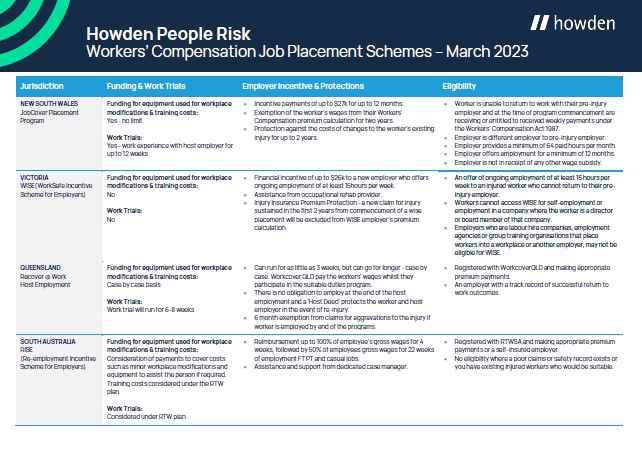The challenge to find great employees in 2023
With acute labour shortages faced by many employers, the challenge is often not just finding the right people for the job - it's finding people.
The current mismatch between labour supply and demand calls for some out-of-the box thinking to solve the problem. Could part of the solution be using Job Placement Programs?
Employers can identify new candidate pools while being rewarded directly via financial incentives, and indirectly with improved Workers’ Compensation scheme performance and social gains.
Today's employment market
The ABS February readout of unemployment figures confirmed a current unemployment rate of 3.7% - an increase on prior month figures but still hovering close to the lowest levels in half a century.*
Employers continue to experience an exceedingly tight post pandemic labour market, with 90% of CEO's expecting staffing shortages again in 2023.** These supply side concerns are limiting their ability to pursue productive opportunities.
The war on talent
The acute labour shortages and capacity constraints faced by employers has pushed them to fight harder than ever to find and attract talent. When competition for talent first began to intensify in the earlier stages of the pandemic, many employers responded with salary increases and an unprecedented focus on the health and wellbeing of employees.
Next came the proliferation of remote and flexible working conditions and other changes to promote a more inclusive workplace culture, helping attract a more diverse range of candidates.
Many employers are now looking to new areas to source labour.
No longer confined to the local area to find talent, some employers, particularly those in primary industries, have opened their recruitment to a global talent pool, using government initiatives like the PALM scheme to source international labour.
Whilst this ‘war on talent’ has been a boon for most employees, and a positive for employers who will be left with a more diverse, engaged and productive workforce, in the short term, employers are still needing assistance to address the labour shortage.
Undiscovered talent accessed via Job Placement Programs
Could part of the answer be in the existing pool of workers that have experienced an injury or illness and are transitioning back into the workforce?
This pool consists of a large cohort of candidates who are work-ready, have demonstrated experience and transferrable skills, but for various reasons are unable to return to their original employment.
For workers with a previous psychological injury, often the environmental context in which they were working was the primary reason that they could not return to their previous work environment.
In instances where psychosocial hazards such as sexual harassment, bullying, and exposure to trauma were unresolved, an opportunity to change the context of work can have a dramatic positive impact on transitioning back to work. Provided they aren’t being thrown into a new environment with the same psychosocial hazards that injured them in the first place, many of these workers will thrive in a new, mentally healthy workplace.
What do these incentive schemes look like and how can they be accessed?
There is a significant variation in the range of incentives offered across the jurisdictions, including their flexibility and duration, and who they are available to. Most indemnify employers from the financial impact of re-injury, exclude their salary from Workers’ Compensation premium and provide incentive payments. Many provide funding for Workplace modifications and equipment.
Download our comprehensive overview here: Howden Job Schemes Overview March 2023.
Despite the current labour market conditions, these incentive programs remain chronically underused. We believe much of this comes down to low awareness and/or understanding of how to adapt a culture of wellbeing to safely on-board and support these workers.
By leveraging various job placement programs around the country, employers can address their staffing challenges while concurrently driving better social and societal outcomes. At a financial level, their use can help reduce scheme liabilities, in turn improving their viability and capacity to lower premium rates for employers.
At Howden, we are able to help you understand what programs may be able to address your people risk challenges and ensure your workforce is future focussed, flexible and adaptable to change in psychosocial hazards. Please talk to us if you would like further information.
*Australian Bureau of Statistics (Reference Period: February 2023) Labour Force, Australia, ABS Website, accessed 2 Mar 2023.
**CEO reference: Source: Australian Industry Group Annual CEO Expectation Survey
For more information on the topics discussed in the article please contact Christian Lombardo.
Christian Lombardo
Partner, People Risk
E [email protected]
M+61 0493 103 333
